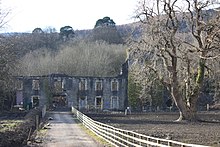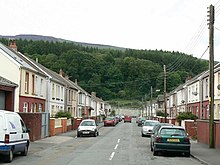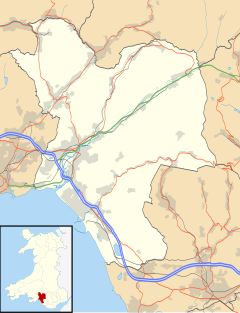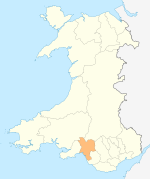Glynneath
Glynneath
| |
|---|---|
 Glynneath Town Hall | |
Location withinNeath Port Talbot | |
| Population | 4,278 (2011)[1] |
| OS grid reference | SN885067 |
| Community |
|
| Principal area | |
| Preserved county | |
| Country | Wales |
| Sovereign state | United Kingdom |
| Post town | NEATH |
| Postcode district | SA11 |
| Dialling code | 01639 |
| Police | South Wales |
| Fire | Mid and West Wales |
| Ambulance | Welsh |
| UK Parliament | |
| Senedd Cymru – Welsh Parliament | |
Glynneath(Welsh:Glyn-nedd"valley of theRiver Neath"[2]), also speltGlyn-neathandGlyn Neath,is a town,communityandelectoral wardlying on theRiver Neathin thecounty boroughofNeath Port Talbot,Wales. It was formerly in the historic county ofGlamorgan.Glynneath wardcovers only part of the community, with some 840 electors included in the neighbouring ward ofBlaengwrach.
Industrialisation reached Glynneath when coal mining started in 1793, and rapidly expanded when theNeath Canalcame to the town in 1775. Many features of the old canal still survive to the present time.[3]
There are waterfalls to the north east atPontneddfechannear theBrecon Beaconsand large parts of the rural area are heavily forested.
Notable buildings and structures
[edit]

Glynneath is home to the ruins ofAberpergwm House.Once owned by Rhys ap Siancyn, Aberpergwm House became the home of the Williams family, Welsh gentry with a strong tradition of using the Welsh language over English. Their descendants include the last of the Welsh household bardsDafydd Nicolasand folksong collectorMaria Jane Williams.The Williams' family mottoy ddioddefws y orfu(He who suffers, triumphs) was adopted byGlamorgan County Council.The mansion itself was remodelled in 1876 but is now derelict and little of note remains of the building.
St. Cadoc's Church,in the grounds of Aberpergwm House, was built as a chapel in the 17th century, rebuilt in 1808-1809 for the Aberpergwm Williams family and extended in 1836–41. It is a Grade II* listed building.[4]
Rheola House,a Regency house designed c.1812 by the eminent architectJohn Nash,is also Grade II* listed.[5]
Glynneath Town Hall is a regularly used civic building situated at Heathfield Avenue. It is owned and managed by Glynneath Town Council.
The Grade II* listed Bethania Community Centre on the High Street is an example of an early Calvinistic Methodist chapel with well detailed external frontage in contrasting stone and iron work railings. The interior has good examples of very finely detailed woodwork.
A bronze statue of the singerMax Boyce,who was born in the town, was erected in the High Street, in September 2023, in recognition of Boyce's 80th birthday.[6]
Sports and leisure
[edit]Glynneath used to host one of motor sport's most important challenges, the British round of theWorld Rally Championship(formerly known as the Lombard RAC rally orRally GB). Some of the biggest names in motor sport have taken part and have failed to complete the British round.
Glynneath also has an association with downhillmountain bikingwith the Welsh National Championships being held at Rheola.
Glynneath is home toGlynneath RFC,arugby unionclub founded in 1889.
Glynneath also boasts an active group of football clubs and a well attended tennis club. Until recently, Glynneath Bowls Club, in particular the Ladies' Bowls Club was an active group.
Glynneath Leisure Centre, maintained through Celtic Leisure is situated just off of Chain Road.
Notable residents
[edit]- The Anchoress,musician, was born in the town.
- Max Boyce,comedian and singer, closely linked to Welsh rugby culture.
- Julie Gardner,television producer, responsible for the successful relaunch ofDoctor Who.
- Leslie Hardman,British Armychaplainandrabbi,who was among the liberators ofBergen-Belsen concentration camp,was born in the town.
- Ruth Madoc,actress, best known for her role as Gladys Pugh in the televisionsitcomHi-de-Hi!
- Siwan Morris,actress, who has appeared in the television seriesBelonging,Caerdydd,andSkins.
- Glyn Prosser;Glynneath RFC,Neath RFC,Walesrugby union &Huddersfield RLFCrugby league footballer.
- January Rees,Wales women's rugby union player,comedian[7][8]
- Emlyn Walters,Bradford NorthernandWalesrugby league footballer.
Twin Town
[edit]Glynneath istwinnedwith:
 Pont-Évêque,France, since 1993
Pont-Évêque,France, since 1993
The town twinning supports football matches between the two towns, and a visit by Glynneath Male Voice Choir.
External links
[edit]References
[edit]- ^"Community population 2011".Archived fromthe originalon 3 March 2016.Retrieved12 April2015.
- ^"Geiriadur Prifysgol Cymru".
- ^The Welsh Academy Encyclopaedia of WalesJohn Davies,Nigel Jenkins,Menna Baines and Peredur Lynch (2008) pp322ISBN978-0-7083-1953-6
- ^"Church of Saint Cadoc, Glynneath".British Listed Buildings.Retrieved16 January2014.
- ^"Rheola House, Glynneath".British Listed Buildings.Retrieved16 January2014.
- ^"Max Boyce statue unveiled in his hometown Glynneath".BBC News.30 September 2023.Retrieved21 February2024.
- ^Porter, Nicola (2 January 2002)."Interview - January Rees: I scare men & they love it; Funnygirl January Rees tells why she quit rugby to make it as a rude stand-up".Daily Mirror.London.Retrieved23 July2018.
- ^Haines, Chris (25 December 2008)."January Rees comes to Rhondda".Wales Online.Retrieved23 July2018.


